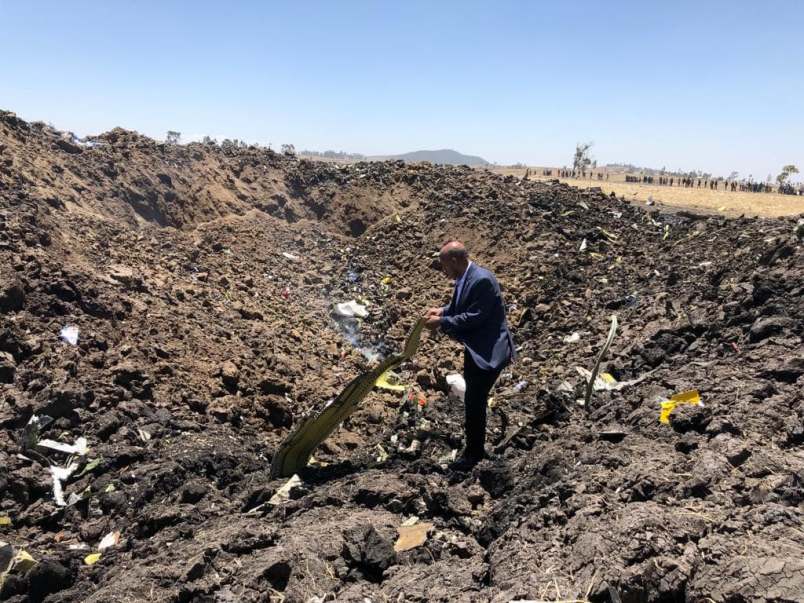ADDIS ABABA, Ethiopia (AP) — An Ethiopian Airlines flight crashed shortly after takeoff from Ethiopia’s capital on Sunday morning, killing all 157 on board, authorities said, as grieving families rushed to airports in Addis Ababa and the destination, Nairobi. More than 30 nationalities are among the dead.
It was not immediately clear what caused the crash of the Boeing 737-8 MAX plane, which was new and had been delivered to the airline in November. The pilot sent out a distress call and was given clearance to return, the airline’s CEO told reporters.
The state-owned Ethiopian Airlines, widely considered the best-managed airline in Africa, calls itself Africa’s largest carrier and has ambitions of becoming the gateway to the continent. It is known as an early buyer of new aircraft as it assertively expands.
The airline said 149 passengers and eight crew members were thought to be on the plane. Kenyans, Canadians, Chinese, Americans, Ethiopians, Italians, French, British, Egyptians, Indians, Slovakians and others were among the dead, said the airline’s CEO, Tewolde Gebremariam.
The plane crashed six minutes after departing Addis Ababa on its way to Kenya’s capital, plowing into the ground at Hejere near Bishoftu, or Debre Zeit, some 50 kilometers (31 miles) south of Addis Ababa, at 8:44 a.m.
The airline later published a photo showing its CEO standing in the wreckage. Little of the plane could be seen in the freshly churned earth, under a blue sky.
“Tewolde Gebremariam, who is at the accident scene now, regrets to confirm that there are no survivors,” the post on social media said. “He expresses his profound sympathy and condolences to the families and loved ones of passengers and crew who lost their lives in this tragic accident.”
The plane had showed unstable vertical speed after takeoff, air traffic monitor Flightradar 24 said in a Twitter post. Visibility was clear.
State broadcaster EBC reported that 33 nationalities were among the victims. The airline’s CEO said those included 32 Kenyans and nine Ethiopians. Authorities said other victims include 18 Canadians; eight each from China, the United States and Italy; seven each from France and Britain; six from Egypt; five from the Netherlands and four each from India and Slovakia.
The airline has said 157 people were thought to be on board.
The Ethiopian prime minister’s office offered its “deepest condolences” to families. “My prayers go to all the families and associates of those on board,” Kenya’s President Uhuru Kenyatta said.
The Addis Ababa-Nairobi route links East Africa’s two largest economic powers and is popular with tourists making their way to safari and other destinations. Sunburned travelers and tour groups crowd the Addis Ababa airport’s waiting areas, along with businessmen from China and elsewhere.
At the airport in Nairobi, worried families gathered.
“I came to the airport to receive my brother but I have been told there is a problem,” Agnes Muilu said. “I just pray that he is safe or he was not on it.”
“Why are they taking us round and round, it is all over the news that the plane crashed,” said Edwin Ong’undi, who had been waiting for his sister. “All we are asking for is information to know about their fate.”
The Boeing 737-8 MAX was new, delivered to Ethiopian Airlines in mid-November, the airline’s CEO said. Its last maintenance was on Feb. 4 and it had flown just 1,200 hours. The pilot was a senior one, joining the airline in 2010, he said.
In a statement, Boeing said it was “deeply saddened” to hear of the crash and that a technical team was ready to provide assistance at the request of the U.S. National Transportation Safety Board.
In October, another Boeing 737-8 MAX plunged into the Java Sea just minutes after taking off from Jakarta, Indonesia’s capital, killing all 189 people on board the plane Lion Air flight. The cockpit data recorder showed that the jet’s airspeed indicator had malfunctioned on its last four flights, though Lion Air initially claimed that problems with the aircraft had been fixed.
The last deadly crash of an Ethiopian Airlines passenger plane was in 2010, when the plane crashed minutes after takeoff from Beirut killing all 90 people on board.
Sunday’s crash comes as the country’s reformist prime minister, Abiy Ahmed, has vowed to open up the airline and other sectors to foreign investment in a major transformation of the state-centered economy.
Ethiopian Airlines’ expansion has included the recent opening of a route to Moscow and the inauguration in January of a new passenger terminal in Addis Ababa to triple capacity.
Speaking at the inauguration, the prime minister challenged the airline to build a new “Airport City” terminal in Bishoftu — where Sunday’s crash occurred.
___
Follow Africa news at https://twitter.com/AP_Africa







Need to wait for the facts, but Boeing has some ‘splaining to do.
That sounds like engine problems.
Progress has it’s faults,at times deadly.
“Sunday’s crash comes as the country’s reformist prime minister, Abiy Ahmed, has vowed to open up the airline and other sectors to foreign investment in a major transformation of the state-centered economy.”
Indeed. The Lion Air crash that recently killed everyone on board was also a Boeing 737 MAX 8.
Could also be Boeing’s automatic stall software that they “forgot” to tell anyone about kicking in… Again.